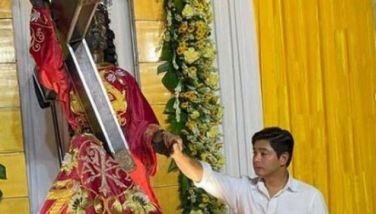Where is Madame Mao?
Then: March 1985
Everywhere in China, people are still talking about Madame Mao (Xiang Xing), the last wife of the late Chairman Mao, who was part of the “Gang of Four” that was behind the cultural revolution.
Our guide in Beijing, Su an long, tells us very frankly that “Chinese people love chairman Mao but hate Madame Mao.” He then adds that the late Chairman never lived with Madame Mao but she made the Chinese people believe that her orders actually came from the Chairman.
“She was a bad woman,” he continues and we wonder whether he meant it in another sense.
The “cultural revolution” instigated by “The Gang of Four” lasted for 10 years. It is now blamed for the ills that China suffered during those years. Madame Mao was the highly visible person behind the group during those years. Though still adhering to the tenets of Chairman Mao as far as clothing was concerned, Xiang Xing was known to liven up her Mao suit with Dior stockings and European shoes. For us, this seems petty compared to the excesses of some of our leaders, but for the Chinese, who had to bear the brunt of all the hardships, reports like this have been enough to sow hatred.
In Harbin, a city in the northeast part of China known for its ice lantern festival, our guide, Rock, who is a young doctor, once again stresses the malignancy of Madame Mao’s reign over Chairman Mao. “The Chairman did a lot of good things for the Chinese people but in the latter years, he made mistakes while he was under the control of Madame Mao.”
Other sources in Beijing tell us that Xiang Xing is now living in a house in the suburbs. She is not allowed to do any interviews. Some members of the press staying in Beijing attest to this. “She is under house arrest and is not allowed to interact even with her neighbors,” a Chinese professor tells us. “Now she watches TV, works in her garden and does some reading. She is finally living the life of ordinary citizens like us.”
 The controversial fourth wife of China’s Chairman
The controversial fourth wife of China’s Chairman My quest on some news on Madame Mao brings me to China, visiting provinces of northeast China like Harbin, Changsun and Shenyang. The temperature (first two weeks of February) is 10 to 20 degrees below zero. It is really freezing in Beijing as in Shenyang. Our airplane could not take off because of the heavy snow. Nevertheless, China is already presenting a changing face. For one, there are lots of colors already. The black and grey Maos are interspersed with women wearing blue, red, yellow and fuschia.
The women of China are coming into their own and some of them are holding top positions in government and the academe. Women and child welfare are top priorities and women are working hand in hand to rebuild the nation.
For the China trip, I am with a big Filipino group that includes businessmen and travel executives and we are staying here for 16 days. We get stranded in Beijing for four days when the plane that is supposed to take us back to Manila developed engine trouble. Part of our group is Lily Juico whose husband is in the travel industry. She herself is the vice president of the Philippine Travel Bureau.
When we discover that we will be spending Valentine’s Day in Beijing, we greet Lily “happy anniversary” — it was her 43rd. And judging from the laughing eyes of Lily, obviously, hers is a good marriage and a good life.
Even in China, a lasting marriage is a rarity. Divorce has been on the rise since the adoption of a new Marriage Law in 1981. About 500,000 divorces are granted every year. Some 70 percent of the divorce filing are made by women.
Now: April 19, 2011
Xiang Xing later came to be known as Jiang Quing. An actress before becoming the fourth wife of Chairman Mao in 1938, she had a daughter with him named Le Ni in 1940. Madame Mao became the most visible figure in Chinese politics when Chairman Mao was already sick. She dealt with international personalities like Richard Nixon when he visited China. During the political decline of the Marcoses in 1986, most activists refer to Mrs. Marcos as the Madame Mao of the Philippines. Even their horoscopes have shown similarity. Mrs. Marcos and her family were exiled to Hawaii after the EDSA Revolution. Madame Mao was arrested soon after Chairman Mao’s death in October 1976. A trial court sentenced her to death but this was later reduced to life imprisonment. While in prison she was diagnosed with throat cancer but refused an operation. She was released from prison in 1991 for medical reasons. At the hospital, Jiang Quing committed suicide by hanging herself in the bathroom of her hospital room. She was 77.
- Latest
- Trending































